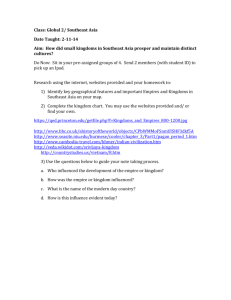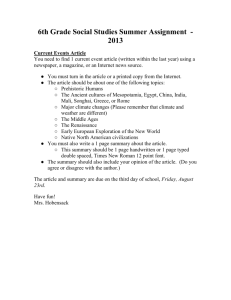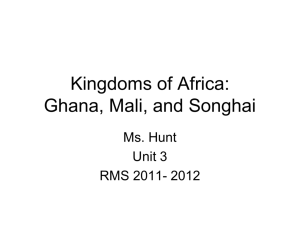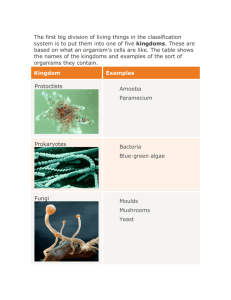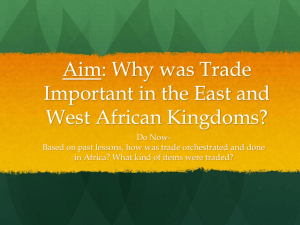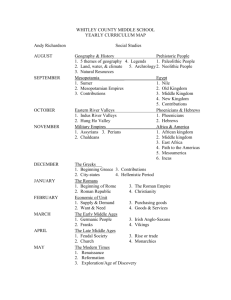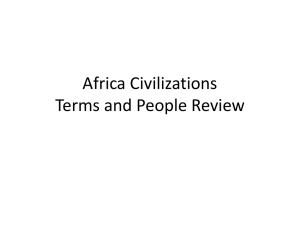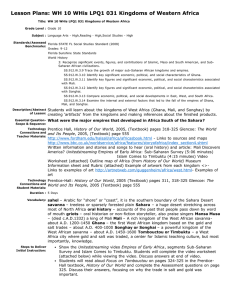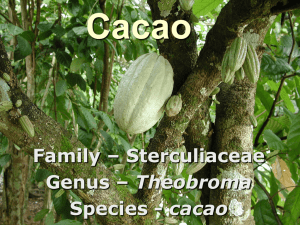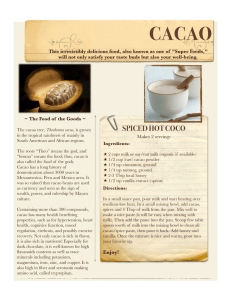World History (12/8)
advertisement
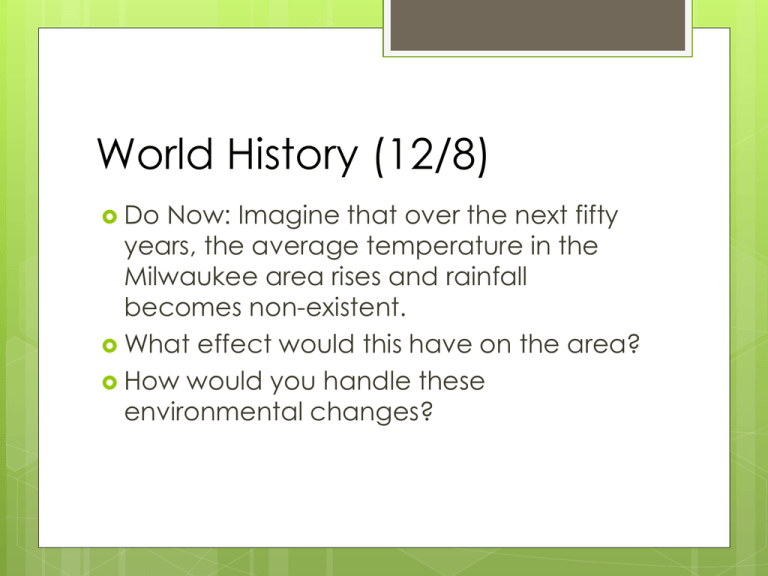
World History (12/8) Do Now: Imagine that over the next fifty years, the average temperature in the Milwaukee area rises and rainfall becomes non-existent. What effect would this have on the area? How would you handle these environmental changes? The desertification of Africa Farming dominated Africa from 5500 BCE By 2500 BCE the Sahara region had turned to desert Desertification Reaction? Movement of people north (Mediterranean region) and south Between 500-1500 CE another migration known as the Bantu Migration (this was the root language of the migrating people) Shoulder partner-What effects might this migration have had on Africa? Where are these places? Use your textbook (pg. 285 and 295) to locate and label the following on your outline map The Sahara Desert The Great Rift Valley The Zambezi River Niger River Congo River Indian Ocean Red Sea Atlantic Ocean Kingdom of Ghana (800-1000 CE) Kingdom of Mali (1200-1450 CE) Kingdom of Songhai (14501600 CE) World History (12/9) Do Now: What does the picture to the right have to do with the kingdom of Mali? What does the story of Sundiata (the Lion King) tell us about the values/beliefs of Mali? What characteristics of an empire builder are present in this story? Influences on Africa Resources-in the kingdoms of West Africa gold and salt What else is traded from Africa that ends up having a huge impact on America? Trans-Saharan network (supply and demand) Islam-education and trade connections Welcome to beautiful… Imagine that you are a member of the chamber of commerce from one of the three West African kingdoms It is your job to promote your kingdom and show why people would want to live there or trade with it Use pp. 289-293 in your textbook to acquire background information on each of the three kingdoms (Ghana, Mali, Songhai) Welcome to…example Watch the following video and take notes on: Social features (if any) Political features (if any) Religious features (if any) Intellectual features (if any) Technological features (if any) Environmental features (if any) Record at least THREE examples from the video How do the visuals encourage people to visit this place? World History (12/10) Do Now: What is this map attempting to show? What do the red lines indicate (hint: look at the years)? Why might this be occurring (inference)? How is it similar to this? Beringia Ice age land bridge between Siberia (Russia) and Alaska (North America) Theory: This is how the first people arrived in North and South America Paleolithic people made their way across this bridge following herds of animals Climate warms ice melts bridge under water game animals decrease people adapt by developing farming techniques migrate east and south World History (12/11) Do Now: Read the quote below: “This drink is the healthiest thing, and the greatest sustenance of anything you could drink in the world, because he who drinks a cup of this liquid, no matter how far he walks, can go a whole day without eating anything else.” Member of Hernan Cortes’s crew (circa 1510) What do you think this person is describing? Why? What WAS he talking about? A beverage made from cacao pulp Cacao beans are used to make chocolate What is the connection to the Americas and to their empires? From An Uncommon History of Common Things First harvested and used by the Maya, chocolate was initially a beverage, and not a particularly sweet or smooth one. A Spanish missionary said of it in the 16th century: “Loathsome to such as are not acquainted with it, having a scum or froth that is very unpleasant to taste.” Despite its off-putting taste…the chocolate drink was intriguing enough to be brought back to Europe. While Columbus did discover cacao pods, their appeal was only recognized in 1510 by Hernan Cortes, who brought three chests of pods back…For the next 250 odd years, chocolate would increase in popularity and availability in Europe. Unfortunately, this also meant that the English, French, and Dutch growers relied heavily on slave labor to cultivate crops. FQR=Fact/Question/Response Use the assigned reading and the FQR handout As you read, record facts Whatever you find important or interesting In the question section, record questions you have about the facts The question should not be answered by the fact In the response section, record something that pops into your mind when reading this Make a connection to your own life/experiences/prior knowledge/etc. Part One: The Olmec What is THAT thing? World History (12/12) Do Now question: Based on what you have read so far, what is the answer to the question below? Which of the following BEST explains the Mesoamerican civilization’s practice of human sacrifice? A. They were harsh and brutal people. B. It was part of their religious beliefs. C. It was part of their political beliefs/practices. D. They hated the Spanish and used this as a way to get back at them. Part Two: The Mayans What are they doing? Part Three: The Aztecs What is he doing? Part Four: The Incas What happened to her? What have scientists discovered about her? The Incas (part two) What was this place? World History (12/15) Do Now: Record two similarities and two differences about these Mesoamerican empires at the bottom of your FQR sheet Show these to me before you leave the classroom today How are empires created? What conditions must exist? Power vacuum Environmental mosaic (variety of resources) Military strength Strong leadership Where are the ancient civilizations?
